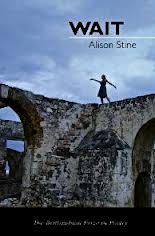Book Review
Alison Stine, Wait [Winner of The Brittingham Prize in Poetry], UW Press, 2011
Reviewed by Susan Delaney Spear
“I want you to find me. Tell me wait,” (4) Stine invites in the collection’s prologue piece, “Wife.” Wait covers a year’s time before a young woman marries, and during this period of waiting the oblique narrative thread moves the speaker out of a failing relationship and into a thriving one. This volume contains a storyline, but the reader must piece the plot together as one might work on a mind-bending puzzle. Stine fills her work with the Midwestern landscape, dark sexual illusions, fairy tales, a Raphael painting, interpreting for the deaf, small town gossip and more. The word wait repeats again and again, but the waiting in this book is not toe-tapping boredom. Stine’s signature mark is surprise: magical realism, auditory pleasure, the interweaving of the literal and the intuitive, the shockingly gothic. The prosodically unexpected waits to be found on every page, but the path to discovery is neither linear nor logical.
Suspend literal analysis when reading “Letter after Dismemberment,” and notice the poem’s narrative arc:
now that I am everywhere,
In earth and in ash, in the stomach
Of the one who swallowed me. And then,
When they killed him, sent him into the air
In a chambered cloud, the flies that erupted
From his belly, spun with blood, the grass,
The goats, the milk they gave…” (35)
The poem begins when a woman leaves a lover who would not “slip [her] into the squares of an ice tray, / though [she] asked” (34) to the same woman being “…everywhere, / in earth and ash…” and finally resting “in a girl” and “wanting / to ask for it. Then asking.” These words defy literal comprehension, but invite intuitive understanding. The poem both begins and ends with asking, possibly an asking to be loved completely. The person who has been dismembered says, “Such mystery, / the divided flesh” (34). The poem itself is mysterious but not opaque.
In the midst of mystery and surprise, Stine’s musical language invites us into the concrete landscape of the Midwest, which she uses to show the awful progression of a relationship between the speaker and a significant other, the “thief.” The thief “took the pond, soured green”; the thief took the “dirt for the hill/ because the hill / was thin, too thin to hold the feet of ferns” (34.) Not only did this villain rob the natural world, “he took mold / from the mortar, and dammed the stream, / dammed my arms, damned my lips, damned / my breasts. / Goddamn my dress” (13). Stine plays with sound to move seamlessly from the literal to the intuitive, to the profane.
Stine juxtaposes unlikely images and stories to great effect in single poems. Her ability to surprise and stretch the mind is arguably her greatest poetic strength.
“What to do with the balloons?.... / ….There are too many on the floor, stirred up / as I stir. In the end, I cut them, urge a blade…. / …It revels what they are:…/ I’ve seen this before, in the newspaper picture of Nefertiti, / bound in the antechamber of a tomb, / cast out of favor…” (38). Balloons? And Nefertiti? These unexpected comparisons reign in Stine’s work. The moving and slightly more linear poem “Clean” places side by side the experience of a principal combing students’ hair (looking for lice?) and a young girl waiting “for color / to spread across the white stick, the red line / signifying [her] plurality” (63)—a pregnancy test. A shocking comparison, not easily forgotten.
Stine crafts her poems in several forms, one of which has lines of eight to twelve syllables but does not divide into stanzas. These lines possess a rhythm and contain no extraneous fluff, but do not fall into any formally metrical pattern. In another signature form she alternates single lines with couplets. Several poems appear in couplets and tercets. Given Stine’s vast imaginative power, it would be interesting to see her experiment with and expand the forms she employs.
A photographer on a fire-escape snapping pictures through a window of men abusing a woman (rape?), a terrible accident in which a drunk jumps from a hotel balcony, a woman jabbing her chest with pins, and other like subjects make Wait a gothic volume. Stine does not fear the morbid or the dark, but the loosely woven story does not end there. The book turns toward brightness (for lack of a better word) and love. In section four she hints at a permanent relationship, real estate, and step parenting. This volume rewards rereading, as the individual poems speak to and for each other, creating a unified whole. The last line of the last poem, “…I will wait for you. / I will wait for you there” (71) both echoes and answers the final line of the first poem, “I want you to find me. / Tell me wait” (4).
Susan Spear is an affiliate professor of English at Colorado Christian University. She earned an MFA in the Verse forms of Poetry from Western State Colorado University. Her poems have appeared in Academic Questions, The Lyric, Mezzo Cammin, and Relief. She also loves music and serves as a choir accompanist and church organist. She lives on the eastern plains of Colorado with her husband. They have three grown children.


